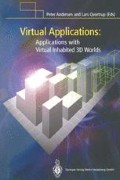Abstract
What does it look like “behind the scenes” of an interactive virtual environment? What technical functionalities are required to support the simulation of a virtual world, populated by computer-controlled characters which interact with each other, and even interact with user-controlled characters? How can we design a system that gives the user the feeling that he or she is influencing a virtual world, has some control over what happens, and has possibilities for creating his or her own experiences?
Access this chapter
Tax calculation will be finalised at checkout
Purchases are for personal use only
Preview
Unable to display preview. Download preview PDF.
References
Angel, E. (2000) Interactive Computer Graphics: a Top-Down Approach with OpenGL, 2nd edn. Reading, MA: Addison-Wesley.
Astheimer, P. and Rosenblum, L. (1999) A business view of virtual reality. IEEE Computer Graphics and Applications, 19(6), 28–32.
Benford, S. and Fahlèn, L. (1993) A spatial model of interaction on large virtual environments. In Proceedings: 3rd European Conference on Computer Supported Cooperative Work, Milan, Italy.
Bjørnstrup, J. (2002) Making 3d models of real world objects. In Qvortrup, L. et al (eds.) Virtual Space: Spatiality in Virtual Inhabited 3D Worlds. London: Springer-Verlag, pp. 93–111.
Brøndsted, T., Nielsen, T. D. and Ortega, S. (1999) Affective multi-modal interaction with a 3d agent. In Proceedings: Eighth International Workshop on the Cognitive Science of Natural Language Processing, Galway, Scotland, pp. 102–109.
Brooks Jr., F. P. (1999) What’s real about virtual reality? IEEE Computer Graphics and Applications, 19(6), 16–27.
Carlsson, C. and Hagsand, O. (1993) Dive — a platform for multi-user virtual environments. Computer & Graphics, 17(6), 663–669.
Concept (2002), ‘Penny+giles computer products’, http://www.conceptkey.co.uk/.
DeLoura, M. (2001) Game plan — on game engines. Game Developer, January, p. 4. (This article is a one page “letter from the editor”.)
Foley, J. D., van Dam, A., Feiner, S. K., Hughes, J. F. and Phillips, R. L. (1994) Introduction to Computer Graphics. Reading, MA: Addison-Wesley.
Granum, E. and Musaeus, P. (2002) Constructing virtual environments for visual explorers. In Qvortrup, L. et al. (eds.) Virtual Space: Spatiality in Virtual Inhabited 3D Worlds. London: Springer-Verlag, pp. 93–111.
Greenhalgh, C. and Benford, S. (1995) Massive: a distributed virtual reality system incorporating spatial trading. In Proceedings: 15th International Conference on Distributed Computing Systems, Vancouver, Canada, pp. 27–34.
Madsen, C. B. and Granum, E. (2000) Aspects of interactive autonomy and perception. In Qvortrup, L. (ed.) Virtual Interaction: Interaction in Virtual Inhabited 3D Worlds. London: Springer-Verlag, pp. 182–209.
Madsen, C. B., Pirjanian, P. and Granum, E. (1999) Can finite state automata, numeric mood parameters and reactive behaviours become alive? In Proceedings: Workshop on Behavior Planning for Life-Like Characters and Avatars, held in conjunction with the 13 Spring Days, Sitges, Spain.
Martin, K. (1999) Using bitmaps for automatic generation of large-scale terrain models. Game Developer, October, pp. 48–53.
Olsen, J. (2002) Game plan — so it’s come to this. Game Developer, July, p. 2. (This article is a one page “letter from the editor”.)
Paggio, P., Jongejan, B. and Madsen, C. B. (2000) Unification-based multimodal analysis in a 3d virtual world: the staging project. In Proceedings: Twente Workshop on Language Theory, “Interacting Agents”, Twente, The Netherlands.
Peasley, M. (2001) Terraforming, Part 2. Game Developer, April pp. 32–38. (This is part 21 of an article that starts in the March 2001 issue.)
Pirjanian, P., Madsen, C. B. and Granum, E. (1998) Behaviour-based control of an interactive life-like pet. Technical Report, Laboratory of Image Analysis, Aalborg University, Aalborg, Denmark.
Rouse, R. I. (1995) Gaming and graphics: what’s your perspective? ACM SIGGRAPH: Computer Graphics, 33(3), 9–12.
Vince, J. (1995) Virtual Reality Systems. Reading, MA: Addison-Wesley.
Watt, A. (1998) 3D Computer Graphics, 3rd edn. Reading, MA: Addison-Wesley.
Watt, A. and Policarpo, F. (2001) 3D Games — Real-time Rendering and Software Technology, Vol. 1. Reading, MA: Addison-Wesley.
Watt, A. and Watt, M. (1992) Advanced Animation and Rendering Techniques, Theory and Practice. Reading, MA: Addison-Wesley.
Editor information
Editors and Affiliations
Rights and permissions
Copyright information
© 2004 Springer-Verlag London
About this chapter
Cite this chapter
Madsen, C.B. (2004). Supporting Interactive Dramaturgy in a Virtual Environment for Small Children. In: Andersen, P., Qvortrup, L. (eds) Virtual Applications. Springer, London. https://doi.org/10.1007/978-1-4471-3746-7_5
Download citation
DOI: https://doi.org/10.1007/978-1-4471-3746-7_5
Publisher Name: Springer, London
Print ISBN: 978-1-84996-891-1
Online ISBN: 978-1-4471-3746-7
eBook Packages: Springer Book Archive

